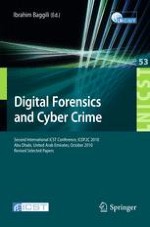This book contains a selection of thoroughly refereed and revised papers from the Second International ICST Conference on Digital Forensics and Cyber Crime, ICDF2C 2010, held October 4-6, 2010 in Abu Dhabi, United Arab Emirates. The field of digital forensics is becoming increasingly important for law enforcement, network security, and information assurance. It is a multidisciplinary area that encompasses a number of fields, including law, computer science, finance, networking, data mining, and criminal justice. The 14 papers in this volume describe the various applications of this technology and cover a wide range of topics including law enforcement, disaster recovery, accounting frauds, homeland security, and information warfare.
